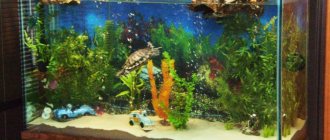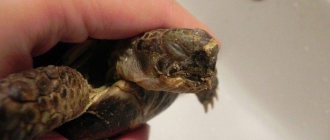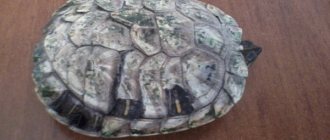How to understand that a pet has died
If it happens that the reptile shows no signs of life, then you need to know how to detect death.
There are several ways to do this, but it should be noted that all of them will be stressful for a living creature and can provoke diseases. Below are all the possible signs of how to tell if your pet is alive or dead:
If the reptile is kept in a cold environment in its home, hibernation has begun, the pet was transported in a container without additional heating, then the animal should initially be heated. To do this, just heat or add warm water. It is important that the reptile does not choke or drown. After this, it can be placed next to a heating source, in other words, under a lamp. In the case when, after the operations performed, there are no signs of life and activity, then the pet may be dead. But it is better to use additional verification measures. You should check your pet's reflexes. The cornea of the eye and pain thresholds manifest themselves perfectly. To test reflexes using pain, you need to take a needle and prick the reptile’s paw a little. If there are reflexes, then she will simply pull her paw and begin to move it. To test reflexes, stimuli should be generated on the cornea. Then the centuries will begin to open and close
To do this, you need to carefully touch the cornea with a blunt metal object. If the eye shows no signs, then this means that the turtle has died. You can also check using an oral examination.
To do this, you should open it and look at the shade of the mucous membrane. In a living reptile it should be pink, perhaps pale or bright, it all depends on the condition of the reptile. A dead individual will have a blue color with gray tones. You can also look at your breathing movements by examining your mouth. This can be seen in the larynx, which must open and close. If the larynx is closed and does not move or is constantly open, then most likely this is a sign of death. Once a turtle has died, its mouth will remain open, even if the owner no longer examines it. You can determine whether a turtle is alive using its heartbeat. True, such an inspection cannot be performed at home. To do this, you need to call or go to the veterinarian. Sometimes sunken eyes are also a sign of death. But it is better not to use this method for a single check, because it is not accurate. And the last thing is the appearance of a foul odor from the pet. It appears when the flesh has already begun to decompose.
How to cope with the death of a pet
Birth and death are natural processes and should not be feared. The death of a pet is a big loss, but you have to accept it in order to move on with your life.
Here are some tips for coping with loss:
- Give vent to your emotions, cry . Tell your family and friends about your problem. Talk about this as much as necessary, your loved ones will understand you.
- Distract yourself from something that makes you happy . Play sports, go to a concert or theater, draw, do renovations, or just spend a couple of days lying on the couch watching your favorite films and TV series.
- Go to a psychologist if necessary. There's nothing to be ashamed of.
- Wait. Time cures. Everything passes, it's true.
A new pet can help you overcome the pain of the death of your previous one
. Don’t despair if an accident happens to your pet. Try to live through the period of acceptance and subsequent adaptation to the maximum benefit. Create and develop. Don't get discouraged, go out with friends, spend time in pleasant company. Later, if you have the strength and desire, you can think about sheltering an animal in need of a roof over your head at home.
Stress
When you just bought a reptile, it is not surprising that it refuses food. It can take her a day to get used to her new place of residence. The animal is stressed, so she refuses to eat. As soon as the pet gets used to the new conditions, it will begin to take food.
At first, you shouldn’t stand near the terrarium for a long time, much less knock on it. Until the animal gets used to it, you should not try to pick it up, so as not to unnerve your pet again.
Moreover, you should not handle baby turtles; babies are very timid and this can become stressful for them; as a result, they stop eating and may even get sick.
Solution
The longer a red-eared turtle goes without eating, the more dangerous its condition becomes. Contact a specialist. If this is not possible, for example, there are no veterinarians in the city who specialize in reptiles, start by checking compliance with the conditions of detention.
- A complete diet. Turtles refuse food they don't like. Replace it, but remember to balance your diet.
- Check if the turtle has enough space in the terrarium.
- Clean all surfaces of the turtle house.
- Remove small rocks and decorations that the turtle might swallow.
- Adjust the temperature.
- Aquatic breeds need a place to rest outside of the water. Check if there is enough space for all the inhabitants of the terrarium.
- Remember, the red-eared turtle at home is very demanding on the quality and purity of water. Install high-quality filters and change the water at least once a week.
- Limit the animal's walks outside the terrarium.
- Make sure that no food remains submerged in the water. It will pollute the water.
- Do not self-treat your pet. Without experience, identifying and treating the disease is not easy.
Red-eared slider: diseases and treatment
- home
- Diseases and treatment of red-eared...
- Red-eared slider: diseases and...
| Date: 1 February 2017 | Category: Diseases and treatment of red-eared turtles | Comments: 1 comment |
turtles in the wild . But at home, the incidence of diseases increases. Experts have not yet fully determined what is associated with the increased risk of pathologies of these reptiles in a home environment, but most of them agree that a decrease in immunity plays a negative role. But the specific causes of possible diseases, the diseases themselves and methods of treating them have been studied quite well.
Causes of diseases
They can vary, but are almost always associated with problems of incorrect content. Nutrition . Susceptibility to disease can be influenced, for example, by diet. The animal must receive in food all the necessary macro- and microelements it needs to maintain good health. Unfortunately, some of these elements are missing or too small in human food. This is why it is recommended to feed your pet turtle with special vitamin supplements.
Colds can be caused by ordinary drafts that form when ventilating home premises. This circumstance should once again convince the owners of ornamental turtles that they need to be kept only in a special terrarium with proper ventilation. In addition, free keeping is fraught with injuries, as a result of which reptiles can develop serious diseases.
Dirty drinking water, poor-quality food, lack of regular water procedures, garbage on the floor of an apartment or house - these are the most common causes of contagious diseases of red-eared turtles. Diagnosing some diseases is quite difficult due to the structural features of the turtle’s body. But if you identify the cause of your pet’s illness, then it is quite possible to determine the nature of a specific disease.
Pneumonia
This dangerous disease can occur either as a result of hypothermia or due to air stagnation in the terrarium. Signs of pneumonia are : * mucous bubbling discharge from the nose (runny nose); * swelling of the eyelids; * rapid breathing through the mouth; * in water the animal floats up sideways (with the affected part of the body facing up); * lethargy and lack of appetite.
If the listed signs are noticed, it is immediately recommended to call a veterinarian at home. The fact is that pneumonia in red-eared turtles is most effectively treated with antibiotics (intramuscular injections), and the dose of the medicine is prescribed by the doctor depending on the size, weight of the patient and the stage of the disease.
Self-administration of injections without a doctor’s prescription often leads to the death of a pet. There is also a folk remedy that can be used regardless of the result of the examination by a veterinarian. It is necessary to brew dry chamomile and hold the turtle over the steam while the solution cools. After cooling (at least +30 degrees), dip it in this solution and hold it in it for 30-35 minutes. During the entire treatment period, it is necessary to maintain the water temperature in the aquaterrarium at +30 degrees.
Bone (shell) diseases
The main symptoms in this case are softening or peeling of the shell. This can occur both due to a lack of ultraviolet radiation (artificial or natural), and due to a lack of calcium in the body. In baby turtles, shell abnormalities indicate the presence of rickets. Detachment of the scutes is also possible when infected with a fungal infection.
In order to prevent softening of the shell, it is necessary to irradiate the terrarium with a special ultraviolet lamp at strict intervals. By the way, similar devices for terrariums from the German company Hagen have proven themselves to be quite good.
It is also necessary to eat chopped fish with bones (it is advisable to grind the bones) to supply the body with calcium. Fungal disease of areas of the shell is easy to identify. Under the peeling shield, brown crusts and a gray coating are visible.
This case is treated by daily washing the affected area with a solution of methylene blue for 30 days. In more complex cases (ulcers and even blood stains are visible under the shield), it is recommended to use clotrimazole medicinal ointment. The ointment is applied to the affected area in the evening, and the patient is left on dry land overnight. During the day, you need to carry out the washing procedure in a blue solution.
Eye diseases
Symptoms of eye disease (conjunctivitis) are as follows: * swollen, reddened eyelids; * discharge of pus around the edges of the eyes; * the turtle tries to rub its eyes with its paws; * decreased appetite, lethargic behavior.
This disease is caused by staphylococci or streptococci, which grow in dirty water. At the initial stage, conjunctivitis is treated with ordinary eye drops (dropped 2 times a day), and for acute conjunctivitis, antibiotic-based eye ointments are used. In general, to eliminate the prerequisites for such eye diseases, it is necessary to change the water in the aquaterrarium more often and keep it clean.
Intestinal diseases
The animal can become infected with parasitic worms (helminths). They enter the body through contaminated foods (fish or meat), as well as after drinking contaminated water. If this happens, you can cure the turtle using a folk remedy: for 5 days, feed it only raw carrots, grated on a medium grater. A dangerous disease is salmonellosis, caused by intestinal bacteria. The animal develops loose stools with a very unpleasant odor, general apathy, and weight loss.
This disease can only be treated in a veterinary clinic, and the sooner the turtle’s , the better. Otherwise, the death of your pet is inevitable.
Disease Prevention
This is a very important factor in the health of a domestic amphibian, and preventive measures are closely related to compliance with maintenance rules. To prevent rickets and softening of the shell, the concentration of calcium in the body should be maintained. Especially for young cubs, bone meal should be added to their food daily.
It will also be useful for adults (1 teaspoon once a week). The risk of intestinal diseases is sharply reduced if you feed your pet only high-quality products. Greens and vegetables must undergo mandatory heat treatment. Don’t neglect special vitamin complexes for turtles.
The aquaterrarium should be kept clean, the water should be changed regularly, waste should be removed, and the required dose of UV radiation, temperature conditions, and normal ventilation should be provided.
Unfortunately, there are not so many veterinarians specializing in the treatment of amphibians. In some localities there are simply no veterinary clinics or offices. However, a recommendation from a veterinarian or an experienced turtle owner can always be obtained via the Internet. The main thing is to do this as quickly as possible and immediately begin proper treatment of your sick pet.
Share news:
Be sure to check out these posts as well:
- Red-eared turtle - where are the ears? www.turtlemy.ru When you look at a red-eared turtle, the question immediately arises: where are the red ears? Where…
- Red-eared slider: intelligence and procreation The red-eared slider can be considered a long-liver. The life span of each individual under favorable conditions can reach 30-40...
- Red-eared turtle: speed of movement and protection from enemies The red-eared turtle, contrary to popular belief, is very agile and fast. With these qualities she...
The entry has the following tags: red-eared turtle disease, red-eared turtle treatment Reproduction of any site materials without an active link is prohibited!
Cremation of turtles
Turtles have been popular since Soviet times and are often kept as pets.
These animals have a high life expectancy, but in an unusual habitat they often get sick.
And if a tragedy occurs and the pet dies, the question arises - what to do with the body. Many, breaking the law, bury their pet in the courtyard of their house or in the country.
This is not the best solution. In civilized countries, this problem has long been successfully solved through cremation, that is, burning bodies to ash, which does not pose a threat to either flora and fauna or humans.
Well, if you get bored, watch films about turtles
Don’t skimp on purchasing the necessary equipment; treating a turtle can become much more expensive and troublesome. Most of the turtles in our homes are Central Asian (land) and red-eared (aquatic), less common are European swamp turtles (aquatic) and Far Eastern Chinese trionics (aquatic). Having decided on the species, take a close look at the turtle.
Examine the turtle's eyes - they should not be constantly closed, swollen, watery, or sunken. A healthy turtle does not drag itself with difficulty along the surface, but steps on all four paws, stretches its neck, exploring the surroundings. The turtle should not make squeaks, wheezes, whistles, or clicks (do not confuse all this with hissing when they are trying to scare you!). The shell of a healthy turtle is quite smooth, without bumps, humps or depressions, evenly convex on top (this is the carapace) and smooth below (this is the plastron).
If the turtle is dead, then it will not move them. She didn't eat for 2 days and they brought her to the veterinarian. Like any other animal, a turtle can get sick. My name is Zina. I am a red-eared turtle. It is advisable to check how turtles sleep sometimes and weigh them. Watching them, you understand that they are not so emotionless and stupid.
In any case, a living turtle does not emit any odors.
5) After 2-3 days, the dead turtle will smell of corpse decomposition. In general, a turtle’s poor condition usually does not begin immediately; it does not die suddenly, but gradually becomes ill with something. Therefore, the owner’s task is to correctly and promptly recognize this deterioration of the condition and take the turtle to the veterinarian in time to begin treatment. 40% (those turtles that survive to be sold often find themselves in such conditions that “it would be better if they died as children” than to suffer in dirty aquariums or on the floor under a radiator).4.
Moreover, by the time of death, turtles often have a whole complex of diseases - from vitamin deficiency and rickets to gout in landlubbers. 1. Buy a turtle only in the warm season, when it is more than 20 C outside. And only in pet stores, and not from hand or in the market. It is better, of course, to take abandoned turtles.2. 5. If you have just bought or adopted a turtle, it is also better to see a veterinarian-herpetologist.
She just hides in her shell and falls asleep. In order not to bury the animal alive, you need to know the main signs of the death of a turtle. If the red-eared turtle does not come out of hibernation with the onset of warm weather, then this becomes the first alarming sign. To do this, you need to take the animal in your arms and touch its face and paws. A living turtle will immediately twitch and try to hide even deeper into the shell.
What can cause a pet turtle to die?
Red-eared turtles often hibernate during the winter.
Thus, they climb into the shell and sleep. Breeders sometimes perceive this phenomenon as the death of a pet, because it is practically impossible to determine whether the reptile is breathing due to the protective shell. In order not to bury your pet alive, you should familiarize yourself with the possible signs of death, as well as the reasons why turtles may die. Of course, if the pet remains in hibernation when the weather warms up, then breeders should be wary. But if the room is cold enough, then the reptile will not wake up. In this regard, it is necessary to create the correct conditions, warm the terrarium and add warm water. If the animal remains in its shell, and there are no other signs of life, then mortality should be determined by other measures.
What can pet turtles die from?
Turtles, even outside the wild, are long-lived.
The causes of death can be divided into two categories: those independent of the pet owner and those dependent.
Independent:
- The animal initially had weak immunity and/or a congenital disease.
- Poor conditions for breeding and keeping at the supplier, poor quality transportation, non-compliance with sanitary standards in the pet store.
Dependent:
- Poorly organized place for reptiles. These include: a small aquarium/terrarium, unsuitable soil, too low/high temperature, excessive/insufficient lighting, drafts in the room with the aquarium/terrarium.
- Poor diet. Turtles prefer a variety of plant foods. Her well-being can be harmed by foods such as: bread, eggs, seafood, meat, sausage, milk, cottage cheese, cheese. Feeding frequency has an impact. Young individuals are fed once a day, adults should be fed once every 2 to 3 days. The lack of vitamins also has a detrimental effect on the turtle's health.
- Lack of water treatments. If you do not bathe the animal once every 1 - 1.5 weeks, it can get sick and die.
- Frequent transportation. A turtle, like any other pet, is best kept alone and not subjected to unnecessary transportation. If this cannot be avoided, then this should be done as carefully as possible in a special container.
At home, with proper care, they can live up to 15 years. Poor diet can kill your pet
Causes
Unfortunately, only 2% of turtles die from old age when kept at home. In older reptiles, the body gradually ages, as a result of which the pet turtle dies from chronic systemic diseases. Much more often, the causes of death of exotic animals at home are:
- improper maintenance of the reptile;
- unbalanced diet;
- lack of vitamins and mineral elements;
- violation of the conditions of transportation or keeping in a pet store;
- congenital pathologies;
- overfeeding;
- infectious and non-communicable diseases;
- decreased immunity.
Congenital developmental disorders or decreased immunity are criteria for natural selection; animals with such developmental defects most often die in the first month of life. 40% of the causes of turtle deaths are due to violation of feeding and keeping conditions at home, 48% due to negligent treatment of animals during transportation and storage in pet stores. Very often, people purchase an already sick, exhausted reptile that has no chance of survival.
Do red-eared turtles hibernate?
Under natural conditions, turtles need winter sleep; it helps them survive the cold and short sunny days. Inhabitants of fresh water bodies kept at home do not need hibernation. By maintaining the same temperature and degree of ultraviolet radiation, the pet will survive the autumn period and only slightly reduce activity. If there are no visible signs of illness, but the turtle is sleeping and not eating, then prepare to “overwinter” for one or two months.
The room for sleeping should be made small, at the bottom there should be a ten-centimeter layer of sand and a little water to create humidity. When you transplant your pet into a house, lower the temperature to 8–10 °C within a week and a half. Place the turtle on the veranda, balcony or take it to the basement. Check your pet regularly and carefully.
Sources
- https://krasnouhaya.ru/uhod/kak-ponyat-mertva-cherepaha-ili-spit/
- https://DelaiSmelo.ru/semya/krasnouxaya-cherepaxa-ne-est
- https://rybkies.ru/bolezni/krasnouhaya-cherepaha-ne-est-vyalaya-i-spit.html
- https://ivethelp.ru/bolezni-cherepax/pochemu-krasnouxaya-cherepaxa-ne-est/
- https://krasnouhaya.ru/uhod/pochemu-cherepaha-ne-est-korm/
- https://pumbik.ru/2099-krasnouhaya-cherepaha-ne-est/
- https://mirzasteklom.com/zhivnost/krasnouxaya-cherepaxa-ne-est-vyalaya-i-spit.html
- https://homkin.ru/cherepahi/priobretenie-cherepah/kak-vybrat.html
- https://petstwins.ru/cherepahi/ot-chego-mozhet-umeret-krasnouhaya/
- https://kotsobaka.com/cherepahi/pochemu-umirajut.html
Hibernation of red-eared turtles at home
Usually, when keeping turtles at home, they do not need hibernation, especially if the optimal temperature is maintained. They can hibernate either at low or high temperatures, thus escaping from cold or heat, and sometimes from lack of food.
But there are specimens that are ready to hibernate, regardless of the conditions of detention. In this case, they should be helped and organized a kind of wintering. Hibernation of red-eared turtles has a positive effect on individuals in terms of producing offspring.
Useful tips
It is more convenient to buy turtles from late spring to early autumn. In the warm season, the likelihood of the reptile catching a cold when delivered home is reduced. It is worth preparing a lockable box with ventilation holes in advance and covering it with paper. Trionics are transported in water or wrapped in a damp cloth.
To bring a reptile home in cold weather, you need a heating pad. The body of cold-blooded animals cannot generate heat on its own, which means that wrapping in fabric will not help to keep warm.
You must take the relevant purchase documents from the seller. This will help you get compensation if the reptile turns out to be sick. Papers may be needed when crossing the border or reselling an animal.
When purchasing a red-eared turtle, or other breeds that are not protected species, the seller must provide a receipt and a veterinary certificate. If the reptile is included in the Cites list, or is listed in the Red Book, special certificates from government agencies and confirmation of the legal origin of the individual will be required.
How to choose a healthy turtle
If you decide to have a turtle at home for your child, it is better not to take risks and avoid shopping in unreliable places. It is advisable to contact a trusted pet store, or look for experienced breeders. You can get acquainted with them at reptile exhibitions.
Signs of health in turtles:
- smooth breathing through the nose without wheezing or whistling;
- absence of defects on the shell and skin;
- does not keep his mouth open for a long time;
- no discharge from the eyes or nose;
- moves on land cheerfully, without falling on its side or stumbling;
- mucous membranes in the mouth are even pink in color.
When purchasing red-eared reptiles and other freshwater reptiles, you should make sure that the animal dives. Reluctance to dive under water may indicate lung problems. Serious sellers can provide a veterinary certificate about the health of the pet.
It is useful to evaluate the living conditions of the turtles from the seller. If the enclosures are dirty, overcrowded, there is an unpleasant odor in the room, and maintenance standards are not observed, the animals may have developmental pathologies.
How to tell if a turtle is dead
You can understand that a red-eared or Central Asian turtle is dying by a change in the behavior of the reptile. Signs of deadly diseases in unusual pets are the following symptoms:
- lack of appetite;
- lethargy;
- immobility;
- lack of response to stimuli;
- reluctance of an aquatic reptile to be in water;
- shortness of breath, wheezing, whistling;
- cough, sneezing;
- swollen closed eyes;
- swelling of the limbs;
- bleeding;
- delamination and deformation of the shell scutes;
- hind limb failure;
- ulcers and weeping wounds on the skin and shell.
Old reptiles can die in their sleep without previous clinical symptoms of disease; in this case, it is impossible to know in advance the possible date of death of a pet. It often happens that a recently active turtle suddenly stops showing signs of life. Wild reptiles hibernate in autumn and summer to survive unfavorable periods. This natural instinct is also preserved in pets, therefore, in order not to bury the animal alive, it is necessary to check whether the turtle is alive.
You can determine that a turtle is dead and not hibernating using the following methods:
- Corneal reflex test. A living reptile, in response to the touch of a metal object on the cornea of the eye, reflexively draws the organ of vision into the orbit or opens the eye. If there is no response, the death of the animal can be assumed.
- Definition of breathing. If you carefully observe the nostrils of a sleeping reptile, you will notice their slight fluttering. You can place a mirror near the reptile’s beak; the moist exhaled air will definitely fog it up. Lack of breathing indicates the death of the animal.
- Position of limbs and head. Turtles sleep with their paws and head retracted into their shell; muscle tone can only exist in a living creature. If the limbs and neck hang down, the reptile is most likely dead.
- Retraction of the lower jaw. You can gently pull back the lower jaw, which in a healthy animal should reflexively close when releasing the hand. An open jaw indicates rigor mortis of the animal.
- Reaction to water in aquatic turtle species. When a freshwater or marine reptile is placed in water with a temperature of 30-31C, the animal begins to move its limbs. The absence of such a reaction most often indicates the death of a pet.
- Determination of the color of the oral mucosa. When opening the jaw, it is recommended to examine the pet’s oral cavity. In a living animal, the color of the mucous membrane is pink, in a corpse it is light gray.
- The appearance of a corpse odor. If after 2-3 days the smell of corpse decomposition emanates from a motionless animal, there is no longer any doubt about the death of the reptile.
Before getting an exotic pet, it is recommended to carefully study the physiology, feeding and care of an unusual animal. Due to the physiological characteristics of reptiles, it can be difficult to determine the signs of death of a pet; a sleeping pet looks like a dead turtle. To avoid irreparable consequences, if there is any doubt that the turtle has died, you should contact a herpetologist.
What do turtles die from, how to determine the death of a pet Please
Red-eared turtles often hibernate during the winter. Thus, they climb into the shell and sleep. Breeders sometimes perceive this phenomenon as the death of a pet, because it is practically impossible to determine whether the reptile is breathing due to the protective shell. In order not to bury your pet alive, you should familiarize yourself with the possible signs of death, as well as the reasons why turtles may die.
Of course, if the pet remains in hibernation when the weather warms up, then breeders should be wary. But if the room is cold enough, then the reptile will not wake up. In this regard, it is necessary to create the correct conditions, warm the terrarium and add warm water. If the animal remains in its shell, and there are no other signs of life, then mortality should be determined by other measures.
How can you tell if a turtle is dead or hibernating?
1. Red-eared slider. 2. 5 centimeters. I don’t know the age, they didn’t tell us when they bought it. Still small. 3. I don’t know, the aquarium is average for fish. Water volume is 4 liters. 5. There is land. A piece of foam. 6. There is a simple 100 watt table lamp. 30-40 centimeters from the land. 7. No. 8. There is no soil. Only a few large pebbles. 9. No. 10. Once every 4 days. Tap water. We stand for 2-3 days. 11. Bloodworms, 1 time every 2 days. They don't eat it in 1 day. And this is enough for them. 12. No, we don’t feed you. 13. Only 2 of these Red Eared Turtles and no one else.
Good afternoon I wanted to ask. Yesterday the turtle was swimming, and today it was lying on its back at the bottom. I turned her over, but she didn’t move. The head and paws were protruding from under the shell. We thought that she had died, but I decided to look for diseases of these turtles to understand why and came across hibernation. I wanted to ask, did she die or hibernate? It’s just not really written anywhere how to determine this. The turtle was always active, loved to bask in the sun or under a lamp with its paws out. Yesterday I was still swimming, everything was fine, but today I’m not moving. Tell me what's wrong with her please!
First, apply a non-sharp metal object to your eye. If the eye twitches and goes into the orbit, she is alive. If there is no reaction, bury it. Secondly, normalize the living conditions for the second turtle. For this purpose I give you my article. We read carefully and implement it 100%
We read and bring it to 100% agreement with the article. If you ignore it, he will die in terrible agony. More precisely, he is already DYING!
Please read all of the following and take it as instructions for use. The content conditions of my article must be 100% consistent.
I would also like to remind you that any deviations from the conditions described below can lead to stress, illness and death. (Hibernation, refusal to go to land, refusal to eat, etc. are a stress reaction to bad conditions and can result in death)
I am writing this article to help people who have become owners of a red-eared turtle. Too often, the cause of the death of these magnificent amphibians is, oddly enough, the nature lovers themselves. My goal is to explain to people that they are responsible for those they have tamed. So the conversation here will focus specifically on freshwater red-eared turtles.
Currently, the red-eared turtle enjoys well-deserved popularity among a huge number of wildlife lovers. Unfortunately, novice hobbyists make a lot of mistakes, which leads to the premature death of animals. I hope that this information will help save the lives of turtles, and therefore give their owners the pleasure of communicating with these charming creatures.
Hundreds of thousands of turtles, once under the roof of a person, as a rule, do not live more than two years. Reason: incorrect content.
Firstly, you need to clearly understand that this animal is cold-blooded. This means that it is extremely dependent on the ambient temperature. Since it does not have the ability to thermoregulate, like say a cat or a dog. The optimal temperature range for the red-eared slider is 26-35 degrees. This is exactly the temperature that natural reservoirs have in the habitats of these animals. This means that this is one of the most important parameters that cannot be left to chance. Room temperature is unacceptable as it is significantly below the permissible temperature threshold. (room temperature is 23-27 degrees - this means that the water temperature is 2-3 degrees lower, that is, 20-24 degrees!)
Proper nutrition is the key to longevity
If the turtle died, but the aquarium, temperature conditions and other rules were observed, then perhaps the owner used the wrong diet, which killed the pet. One of the causes of death may be the use of only special reptile food. Such food should not be used as the main diet. It is recommended to use any dry food for fish or turtles as a treat for your pet and give it in dosed form no more than once a week.
An equally common cause of death is frequent consumption of moths. They can cause your pet to become infected with many diseases. If the moth is stored incorrectly or bred in the wrong conditions, then it is not only harmful, but also brings fatal diseases. It is better to completely exclude such a product from the diet if you are not sure about it.
It is recommended to feed your pet raw fish. In this case, you can use both sea and freshwater, preferably low-fat varieties. It is prohibited to feed trout, salmon, capelin and other types of fatty fish. Also, the basis of a proper diet includes poultry and beef by-products; you can give seafood, such as squid or shrimp. When giving your pets fish, you do not need to clean it or remove bones. They contain many useful vitamins and elements.
By using a healthy diet, you can achieve positive results for your turtle's health. It is imperative to remember that it is strictly forbidden to feed lard, skin or meat with greasy streaks. Reptiles are designed in such a way that they will not be able to digest such a product, nor do they have the ability to regurgitate it. As a result, they may become ill, digestion may be impaired, and even death may occur.
From plant foods, you can feed your pet lettuce, carrots, cabbage and dandelions. It is also possible that they may be fed duckweed or various types of algae. During the summer, you can feed some beetles, worms or insects. Such products can be easily stored in a refrigerator in a glass container. For long-term preservation, you should put tea leaves inside. In this case, every day the worms will need to be washed under running cold water and can be used to feed them constantly.
Alternatively, the worms can be frozen. Before serving them to your pet, you will need to rinse them under highly salted water or wash them in a light solution of manganese. Pets get significant amounts of calcium, carbohydrates and proteins from insects and worms. It can also improve and strengthen your pet’s overall health.
For proper and balanced nutrition, it is recommended to make your own food based on gelatin. To do this, you will need to mince carrots (70 g), cabbage and apple (50 g each), any permitted fish (140 g), squid fillet (100 g), and egg (2 pcs.). Then add milk and water (150 g each) to the resulting slurry. You first need to dissolve gelatin (30 g) in them and add Tetravit (20 drops). After this, add a couple of eggs and mix. Then the food is sent to a refrigerator to harden. Before serving, the food should be cut into pieces and allowed to warm up a little. This food is enough for 10 meals for an adult.
As for the feeding schedule, pets under 2 years of age should be given food every day, and the dose should be such that the turtle can eat in a maximum of 30 minutes. For reptiles over 2 years old, food is given 3 times a week, in the same amount. The main thing is to avoid overeating so that your pet does not become obese.
It is better to feed your pet from a separate container so that the water does not become clogged. All products that enter the water turn into a variety of bacteria, fungi and can cause infectious diseases and even death.
Using all the rules described, you can exclude causes of death. And since the pet is not land-dwelling, you should definitely monitor the purity of the water.
Rules of detention and causes of mortality
No matter how strange it may sound, the main cause of death of red-eared turtles is the breeders themselves. Today, many people have such pets. But unfortunately, novice breeders make a lot of mistakes that lead to death. This is all due to improper maintenance and care of pets. At home, many owners have turtles that are not able to live even 5 years.
Initially, you need to clearly know that turtles are cold-blooded. This means that their existence directly depends on the temperature and microclimate in their terrarium. Animals cannot independently regulate their body temperature, such as dogs or cats. The optimal temperature range for red-eared turtles is from 26 to 35 degrees. This is precisely the value found in natural conditions in ponds and other reptile habitats.
All this means that the temperature regime cannot be left to chance by breeders. The room in which the aquarium with the reptile is located should not be the main indicator for keeping it. After all, if the room is approximately 25 degrees, then the water temperature will be several degrees lower, and this is below the required norm.
When buying red-eared turtles, which live mostly in water, you should carefully approach the issue of maintenance and think through the conditions for this in advance. The reptile's home is a large aquarium with an island of land or a terrarium. For one individual, it will be enough to buy or make an aquarium of 200-250 liters, with 100 liters of volume in water. If there is a pair of reptiles, then the parameters will need to be multiplied in half.
The island itself with land must be located on approximately 3 parts of the entire bottom area. It is made from glass, stone or wood. It all depends on preferences or materials that are available to create with your own hands, in addition, the entrance to the island should be smooth, and all surfaces should be rough. To prevent the turtle from dying prematurely, it is created from natural materials or from those that are not toxic. You also need to additionally equip a ladder for entry.
It is also not allowed to use soil in an aquarium. And if it is used, then it should be twice as large as the reptile’s head. Turtles simply love to taste everything, as a result they can swallow any decorative element or small stones. The result may be suffocation or disruption of the gastrointestinal tract, which ultimately leads to death.
You should be no less careful when handling large elements of decoration. Although turtles are not always large, they are very strong and can break an aquarium with a stone or figurine.
Each island with land must be equipped with special ultraviolet lamps, at a height of approximately 30 cm. They are necessary to maintain the health of the turtle, as well as for the warming up and normal development of the pet. You will definitely need to install a heater in the aquarium. This is because the water must be within a certain temperature range.
All turtles are quite sloppy and create a lot of dirt around themselves. However, they love clean water. Therefore, breeders should buy an additional cleaning filter, which will have double the supply. In other words, if there is 100 liters of water in the aquarium, then the filter should be 200 liters and so on. When changing the water in the terrarium, you should only use settled water. It is prohibited to use water that has been passed through a household filter. Typically, this purification adds silver to the water to remove infections and bacteria. All this slowly poisons the turtles and, as a result, intoxication and failure of the animal’s internal organs begins. After this comes death.
On the way to the answer
With the development of computer technology, people from various fields of activity began to draw analogies between computers and humans. Medicine was not left out of this either. If death is a general dysfunction of all organs, then which one is the most important? Having simplified the functions of the human body as much as possible, scientists began to sort through the components of the human body one by one. So, without an arm or a leg, people are quite capable of existing. It’s hard for a person to lose an eye, a kidney or a lung, but he remains alive. Even instead of a heart, a pacemaker is now inserted. Only the brain still remains an indispensable organ. Its dysfunction means death.











